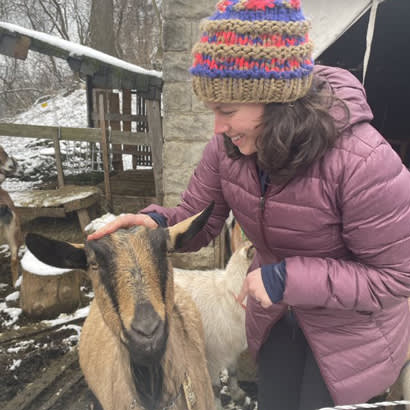
Pictured: Allegheny Goatscape released goats in controlled areas to help reduce invasive and unwanted vegetation along Pittsburgh’s greenways system.
In 2022, 92 percent of Pittsburghers lived within a 10-minute walk of a park or green space. This includes a greenways system that is made up of 12 designated greenways, which amounts to more than 300 acres across the city. The greenways system was developed in 1980 after the collapse of the steel industry and was created as a tool to consolidate abandoned properties, establish a permanent conservation easement for public use and empower communities to address abandoned property in a systemic way that wouldn’t strain city resources.
However, this structure led to a lack of dedicated funding for the city’s greenways, and its reliance on local volunteers and community stewardship has led to inconsistent and sporadic maintenance. The lack of resources reduced recreational opportunities in these areas and, as a result, many of these greenways are in ecological collapse; invasive plants and vines, deer and worm overpopulation, dumping issues and landslides have become more prevalent.
Building a Partnership
In 2020, thanks to a Trust for Public Land grant, the city government launched a Greenways Platform Partnership pilot project to address these ecological issues occurring along the 183-acre Hazelwood Greenway. Through the pilot, the city began to build relationships with community and nonprofit partners to manage the work needed in Hazelwood. This pilot provided an example of how funding and sequencing local partner organizations to conduct greenway placemaking and maintenance can not only create more equitable access to quality parks but also help the city reach its climate action goals.
While the grant funding for the pilot was a catalyst, the strength of the partnership is now amplified because partners are often able to bring their own resources to the project for additional collective impact.
Facilitated by the Pittsburgh Department of City Planning, the city government worked with community-based organizations and residents to decide what work should be completed along the greenway based on each partner organization’s expertise. Once the work was prioritized, the collective of organizations created a timeline of work that was most impactful:
- The Hazelwood Initiative, a registered community organization in the neighborhood, hosted visioning sessions, volunteer events and provided programming to familiarize the community with the greenway.
- Allegheny Goatscape released goats in controlled areas to help reduce invasive and unwanted vegetation, and the community loved visiting the goats at work in the greenway.
- Landforce, a workforce development organization specializing in land management, employed local community members to conduct on-the-ground site prepping, trail building, and stormwater management, working in tandem with the herd of goats from Allegheny Goatscape.
- Tree Pittsburgh, an environmental non-profit, focused on enhancing community vitality by planting trees in areas cleared by the goats and Landforce to restore and protect the urban forest along the greenway.
- Chatham University master's students provided technical support to explore enhanced methods of using natural infrastructure for hillside stabilization and stormwater management.
Expanding Beyond Hazelwood
Using the momentum from the pilot, the Greenways Platform Partnership team won a Resilient Park Access Grant and technical assistance from the National Recreation and Park Association to turn the pilot project into a 2.5-year program. In 2021, Pittsburgh expanded its work in the Hazelwood Greenway. Since this partnership began, the Hazelwood Greenway has seen demonstrable improvements, such as:
- Maintenance of 6,192 feet of existing trail
- Construction of 1,585 feet of new trails
- Removal of invasive vegetation across 5.4 acres
- Planting of 386 trees
- Legislation turning the greenway into a park, unlocking more funding potential
In 2021, the City of Pittsburgh was recognized for the work it has done through its Greenways Platform Partnership program and was selected as a finalist for the Climate Challenge Cup.
In addition to expanding the work in Hazelwood, the city is starting work on other greenways across Pittsburgh, prioritizing communities without adequate access to high-quality recreation and open green space. Based on the model developed in Hazelwood, the expanded greenways program will work on community-identified projects and activities that activate and enhance these community assets and protect residents against the changing climate.
The North Charles Street and Seldom Seen greenways (in the Perry South and Beechview communities of Pittsburgh, respectively) are the latest additions to the program. North Charles Street surrounds the now decommissioned Harlan Avenue right-of-way, and Seldom Seen stretches along the streambanks of Saw Mill Run Boulevard and contains a historic arched bridge. The city is working in each neighborhood to determine community priorities for each greenway. These three greenways, including Hazelwood, represent a wide range of ecological characteristics, recreational opportunities and community desires.
Before the expansion of the Pittsburgh Greenways Platform Partnership program, the efforts of each partner organization were incredibly siloed. For example, one group might have had funding to plant trees, release goats or complete another singular project along a greenway. After creating the partnership, the program can now leverage resources and services and has created a more visible difference for the community and the Pittsburgh ecosystem at large.
Audrey Wells (she/they) is a press officer for the City of Pittsburgh.

